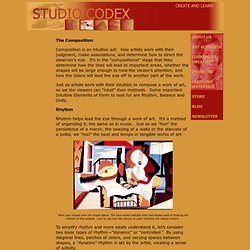

Open-altarpiece.jpg (3500×2600) Mposition: A Series of Exercises in Art Structure for the Use of Students and Teachers: Amazon.co.uk: Arthur Wesley Dow. Book Description Publication Date: 12 Aug 2010 Arthur Wesley Dow was an American painter, printmaker, photographer, and influential arts educator.

He taught many of America's leading artists and craftspeople, including Georgia O'Keeffe, two of the Overbeck Sisters and the Byrdcliffe Colony. Dow was largely inspired by Japanese art to this work on Compositionn. Frequently Bought Together Customers Who Bought This Item Also Bought Product Description About the Author Arthur Wesley Dow (1857-1922) was a painter, printmaker, and writer. Inside This Book (Learn More) Browse and search another edition of this book. First Sentence ANYONE WHO CAN think of "design" in art as a matter of form doing structural more than representational duty is on the way to comprehending the modernist motion of preeminent form as it emerged from design in the decorative (or applied or industrial) arts into an independent "abstract" art, with the positively decorative as transitional to the fully nonobjective.
By P. Mastering Composition: Techniques and Principles to Dramatically Improve Your Painting Mastering North Light Books: Amazon.co.uk: Ian Roberts. Composition Made Easy. Have you ever had a painting that just didn't look right?

Getting the composition of your painting correct can mean the difference between a painting that turns heads and sells in an instant to one that just looks wrong. Trying to fathom out how to compose a painting can be a daunting affair for many artists, especially when working from photographs. Many artists will be surprised to know just how many different types of compositions there are to choose from, most only know of only 3 to 4 at the most. How many can you name? In this course, Dennis reveals ALL 17!!! Dennis has put all his 65 years worth of composition knowledge together in this course to enable all artists to producing better quality paintings. Throughout Dennis uses many photographs, illustrations and animations to show you exactly how to use each composition type. This course is a MUST for the every artist - from the rank beginner to the professional. Composition Types · Erin Sparler.
Art Elements: Composition. The Composition Composition is an intuitive act: how artists work with their judgment, make associations, and determine how to direct the observer’s eye.

It’s in the “compositional” stage that they determine how the lines will lead to important areas, whether the shapes will be large enough to hold the viewer’s attention, and how the colors will lead the eye off to another part of the work. Just as artists work with their intuition to compose a work of art, so we the viewers can “intuit” their methods.
Some important Intuitive Elements of Form to look for are Rhythm, Balance and Unity. Rhythm Rhythm helps lead the eye through a work of art. Move your mouse over the image above. To simplify rhythm and more easily understand it, let’s consider two basic types of rhythm—“dynamic” or “controlled.” Scroll over the image above to see what is repeated to create the rhythm of this piece. Phil Straub Composition Tutorial. Sun 4th Dec 2005, by Phil Straub | Tutorial This article was written by Phil Straub back in 2005, and it is as fresh and vital today as it was then.

Phil’s tips and trick are timeless, and can help you make your images pop! Composition is everything! No amount of detail in an illustration or Concept Painting will be successful without a strong composition foundation. Composition in Environment Concept painting can be quite difficult since your focal point usually isn’t as obvious as in a character piece. DIVINE PROPORTIONS: The Golden Rule and Rule of Thirds When you take the canvas area and divide it into ‘thirds’ Horizontally and Vertically, where the lines cross in the picture area is a ‘Golden Mean’, or the best spot in which to place your Main Subject or Object of Interest as it is the Focal Point of your picture. The golden rule can and usually is applied to a paintings canvas proportions.